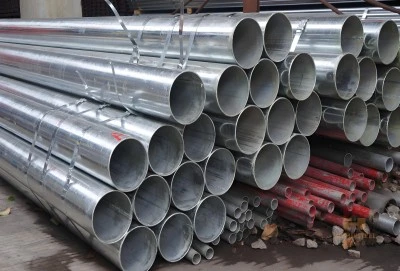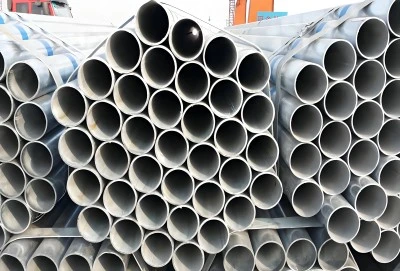Regular Inspections
Regular inspections are crucial for maintaining the integrity and longevity of zinc coated steel pipes. These inspections should be conducted at least annually, with more frequent checks in harsh environments or critical applications. The primary goal of these inspections is to identify any signs of damage, corrosion, or wear that could compromise the pipe's performance or safety.
During inspections, pay close attention to areas prone to damage or corrosion. These include joints, bends, and places where the pipe comes into contact with other materials. Look for signs of white rust, which appears as a white, powdery substance on the surface of the zinc coating. While white rust is not immediately harmful to the steel underneath, it indicates that the zinc coating is being consumed and may require attention.
Also, check for red rust, which appears as reddish-brown spots or streaks. Red rust is a sign that the zinc coating has been compromised and the underlying steel is corroding. This requires immediate attention to prevent further damage. According to a study published in the Journal of Materials Engineering and Performance, early detection and treatment of red rust can extend the life of zinc coated steel pipes by up to 25%.
Use non-destructive testing methods like ultrasonic thickness measurement to assess the remaining wall thickness of the pipes. This can help identify areas of thinning due to internal corrosion or erosion. The American Water Works Association recommends that if the remaining wall thickness is less than 70% of the original thickness, the pipe should be closely monitored or considered for replacement.
|
|
|
Cleaning
Regular cleaning is an essential part of zinc coated steel pipe maintenance. Over time, dirt, debris, and various contaminants can accumulate on the surface of the pipes, potentially accelerating corrosion and reducing the effectiveness of the zinc coating. The cleaning process should be gentle to avoid damaging the protective zinc layer.
For routine cleaning, use a soft brush or cloth with warm water and mild soap. Avoid using harsh chemicals or abrasive materials that could scratch or damage the zinc coating. If dealing with stubborn dirt or grime, a solution of water and white vinegar (in a 1:1 ratio) can be effective. After cleaning, thoroughly rinse the pipes with clean water to remove any soap residue.
In industrial settings where pipes may be exposed to more aggressive contaminants, specialized cleaning methods may be necessary. The National Association of Corrosion Engineers (NACE) recommends using pH-neutral cleaners specifically designed for galvanized surfaces in these situations. Always follow the manufacturer's instructions and safety guidelines when using any cleaning products.
After cleaning, it's important to allow the pipes to dry completely. Standing water on the surface of zinc coated steel pipes can lead to accelerated corrosion. If possible, use clean, dry cloths to remove excess water and ensure proper air circulation to speed up the drying process.
Protective Coatings
While zinc coated steel pipes come with built-in corrosion protection, additional protective coatings can further extend their lifespan, especially in harsh environments. These coatings act as an extra barrier against moisture, chemicals, and other corrosive elements.
One common protective coating is a zinc-rich paint. This type of paint contains a high percentage of zinc dust, which provides cathodic protection similar to the original zinc coating. According to research published in the journal Progress in Organic Coatings, zinc-rich paints can extend the life of galvanized steel by up to 1.5 times in marine environments.
Epoxy coatings are another option, particularly effective in highly corrosive environments. They form a hard, durable barrier that resists chemicals and abrasion. A study in the Corrosion Science journal found that epoxy-coated galvanized steel showed 60% less corrosion than uncoated galvanized steel after 1000 hours in a salt spray test.
When applying protective coatings, proper surface preparation is crucial. The surface must be clean, dry, and free from any loose zinc or corrosion products. For best results, light abrasion with fine-grit sandpaper can improve adhesion. Always follow the coating manufacturer's instructions for application and curing times.
It's important to note that while protective coatings can significantly enhance corrosion resistance, they require their own maintenance. Regular inspections of the coating integrity and touch-ups as needed are essential to maintain protection.
Preventing Moisture Accumulation
Moisture is one of the primary enemies of zinc coated steel pipes. When water is allowed to accumulate and remain in contact with the pipe surface for extended periods, it can accelerate the corrosion process, even with the protective zinc coating. Therefore, preventing moisture accumulation is a critical aspect of zinc coated steel pipe maintenance.
One of the most effective ways to prevent moisture accumulation is through proper design and installation. Pipes should be installed with a slight slope to allow water to drain naturally. The American Society of Civil Engineers recommends a minimum slope of 1/4 inch per foot for horizontal pipes to ensure adequate drainage.
In areas where water accumulation is likely, such as low points in a piping system, consider installing drain valves. These allow for periodic draining of any collected water. Regular checks and draining of these points can significantly reduce the risk of corrosion.
For outdoor installations, ensure that pipes are not in direct contact with soil or vegetation. Use pipe supports or sleeves to create a barrier between the pipe and potential moisture sources. The Zinc Institute recommends a minimum clearance of 6 inches between galvanized pipes and soil to prevent corrosion.
In humid environments, consider using dehumidifiers or improving ventilation to reduce ambient moisture levels. A study in the Materials and Corrosion journal found that reducing relative humidity from 80% to 60% could extend the life of zinc coatings by up to 30% in industrial environments.
For underground installations, cathodic protection systems can provide additional defense against moisture-induced corrosion. These systems use sacrificial anodes or impressed current to protect the pipe from corrosion in wet soil conditions.
Zinc Coated Steel Pipe Manufacturer
When it comes to ensuring the longevity and performance of zinc coated steel pipes, choosing a reputable manufacturer is crucial. LONGMA GROUP stands out as a reliable option in this regard. Their commitment to quality is evident in their adherence to international standards, including API 5L, ASTM A53, EN10210, and AS/NZS 1163.
API 5L, developed by the American Petroleum Institute, sets stringent requirements for line pipes used in the oil and gas industry. This standard ensures that pipes meet specific criteria for strength, dimensions, and coating quality. ASTM A53, established by the American Society for Testing and Materials, covers both black and hot-dipped zinc-coated welded and seamless steel pipe for various applications.
For those in the market for zinc coated steel pipes or seeking more information about proper maintenance techniques, LONGMA GROUP offers direct consultation. Interested parties can reach out to them at info@longma-group.com to discuss specific requirements, learn about their product specifications, or inquire about best practices for maintaining their zinc coated steel pipes in various environments.














